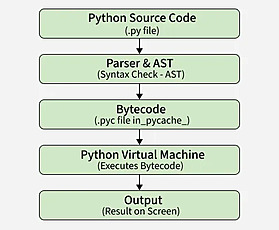What is Python Interpreter
Last Updated : 18 Sep, 2025
A Python Interpreter is the program that reads and executes Python code. It translates your Python instructions into machine-readable form line by line, so the computer can understand and run them.
When you run a Python program, code passes through Python Interpreter, which is responsible for:
- Checking your code for errors.
- Converting it into an intermediate form called bytecode.
- Sending it to the Python Virtual Machine (PVM) for execution.
Working of Interpreter
Let’s understand the step-by-step process of how your Python code runs:
- Python Source Code (.py file): You write your program in a .py file.
- Parser and AST (Syntax Check -> Abstract Syntax Tree): Python checks the code for syntax errors and converts it into an AST (Abstract Syntax Tree), which represents the program structure.
- Bytecode (.pyc file in __pycache__): The AST is compiled into bytecode, a low-level instruction set. This bytecode may also be saved in the __pycache__ folder for reuse.
- Python Virtual Machine (Executes Bytecode): The PVM executes the bytecode line by line and translates it into machine instructions.
- Output (Result on Screen): Finally, the program’s result is shown on the screen (for example, via print()).
To visualize this at a high level, here’s a simple diagram of how an interpreter processes your code:
 Working of Interpreter
Working of InterpreterExample
This program takes two inputs as a and b and prints sum in the third variable which is c. It follows sequential as well as functional execution of programs
Python a = 3 b = 7 c = a + b print(c)
Behind the scenes, here’s what happens:
- The interpreter reads each line.
- Converts it into tokens (a, =, 3, +, b, etc.).
- Builds an AST and then bytecode.
- PVM executes the bytecode and displays 10.
Different Python Interpreter Variants
The default and most widely used interpreter is called CPython, because it is implemented in the C programming language.
- CPython is the official Python interpreter you download from python.org
- Every time you type python script.py, you are using CPython unless you install another interpreter.
Other variants of Python interpreters include:
- PyPy: faster, uses JIT (Just-In-Time compilation).
- Stackless Python: optimized for concurrency.
- MicroPython: lightweight, designed for microcontrollers.
- Jython: runs on the Java platform.
- IronPython: runs on .NET framework.
Difference between Compilers and Interpreters
It’s important to understand how an interpreter differs from a compiler:
Compiler | Interpreter |
|---|
It translates a program on a single run | It executes a program line by line. |
It is an Fast Process | It is an Slow Process |
It generates output in the form of .(exe) | It does not generate any form of outputs. |
It utilizes CPU more. | It takes less utilization of CPU |
It is used in Production environment | It is maximum used in Programming and development environment. |
C, C++, C# are the compiled languages | Python, Ruby, PHP are the interpreted languages. |
It takes lot of time to analyze the code structure | It takes less time compared to compilers. |
Advantages
- Easy debugging: errors are shown immediately line by line.
- Flexible and portable: works across platforms without recompiling.
- No need for separate compilation: just run the script directly.
- Supports dynamic typing: variable types don’t need to be declared.
Disadvantages
- Slower than compiled languages (because it executes line by line).
- Higher memory usage.
- Not ideal for low-level programming (like OS kernels or device drivers).
Explore
Python Fundamentals
Python Data Structures
Advanced Python
Data Science with Python
Web Development with Python
Python Practice
My Profile